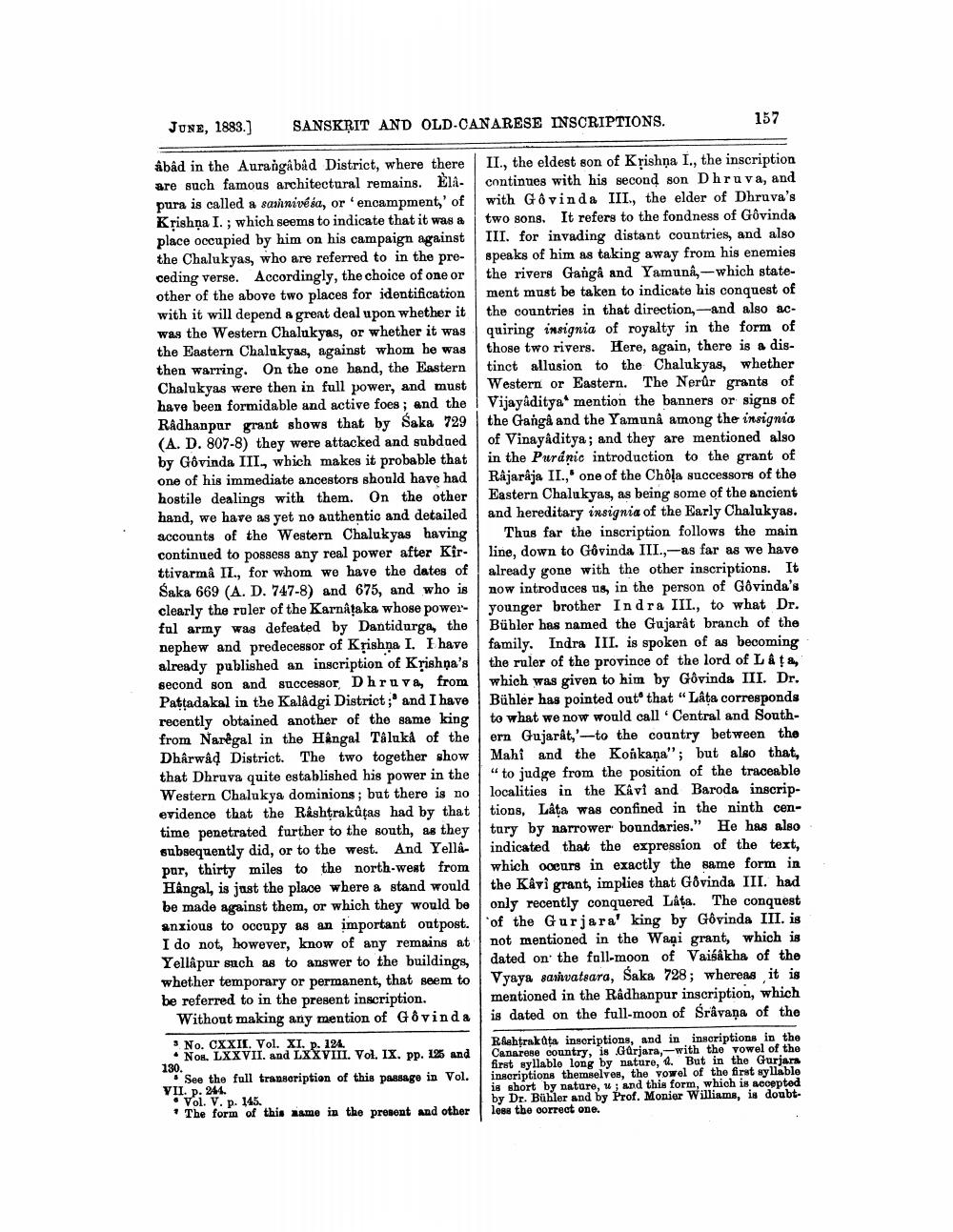________________
June, 1883.)
SANSKRIT AND OLD-CANARESE INSCRIPTIONS.
157
âbâd in the Aurangabad District, where there II., the eldest son of Krishna I., the inscription are such famous architectural remains. EIA- continues with his second son Dhru va, and pura is called a sannivesa, or encampment,' of with Gô vinda III., the elder of Dhruva's Krishna I. ; which seems to indicate that it was a two song. It refers to the fondness of Gôvinda place occupied by him on his campaign against III. for invading distant countries, and also the Chalukyas, who are referred to in the pre- speaks of him as taking away from his enemies ceding verse. Accordingly, the choice of one or the rivers Ganga and Yamuna, - which stateother of the above two places for identification ment must be taken to indicate his conquest of with it will depend a great deal upon whether it the countries in that direction, and also acwas the Western Chalukyas, or whether it was quiring insignia of royalty in the form of the Eastern Chalukyas, against whom he was those two rivers. Here, again, there is a disthen warring. On the one hand, the Eastern tinct allusion to the Chalukyas, whether Chalukyas were then in full power, and must Western or Eastern. The Nerûr grants of have been formidable and active foes; and the Vijayaditya mention the banners or signs of Rådhanpur grant shows that by Saka 729 the Ganga and the Yamunâ among the insignia (A. D. 807-8) they were attacked and subdued of Vinayaditya; and they are mentioned also by Govinda III, which makes it probable that in the Puranic introduction to the grant of one of his immediate ancestors should have had Rajaraja II., one of the Chola successors of the hostile dealings with them. On the other Eastern Chalukyas, as being some of the ancient hand, we have as yet no authentic and detailed and hereditary insignia of the Early Chalukyas. accounts of the Western Chalukyas having Thus far the inscription follows the main continued to possess any real power after Kirline, down to Govinda III., -as far as we have ttivarma II., for whom we have the dates of already gone with the other inscriptions. It Saka 669 (A. D. 747-8) and 675, and who is now introduces us, in the person of Govinda's clearly the ruler of the Karnataka whose power- younger brother Indra III., to what Dr. ful army was defeated by Dantidurga, the Bübler bas named the Gujarat branch of the nephew and predecessor of Krishna I. I have family. Indra III. is spoken of as becoming already published an inscription of Krishna's the ruler of the province of the lord of Lât, second son and successor, Dhruva, from which was given to him by Gôvinda III. Dr. Pattadakal in the Kalâdgi District;' and I have Bühler has pointed out that "Lata corresponds recently obtained another of the same king to what we now would call Central and Southfrom Narêgal in the Hângal Taluka of the ern Gujarât,'-to the country between the Dharwad District. The two together show Mahi and the Konkaņa"; but also that, that Dhruva quite established his power in the "to judge from the position of the traceable Western Chalukya dominions; but there is no localities in the Kavi and Baroda inscripevidence that the Rashtrakůțas had by that tions, Lâta was confined in the ninth centime penetrated further to the south, as they tury by narrower boundaries." He has also subsequently did, or to the west. And Yellá- indicated that the expression of the text, por, thirty miles to the north-west from which oocure in exactly the same form in Hångal, is just the place where a stand would the Kåvi grant, implies that Govinda III. had be made against them, or which they would be only recently conquered Lata. The conquest anxious to occupy as an important outpost of the Gurjara' king by Govinda III. is I do not, however, know of any remains at not mentioned in the Waqi grant, which is Yellâpur such as to answer to the buildings, dated on the fall-moon of Vaisakha of the whether temporary or permanent, that seem to
Vyaya samvatsara, Saka 728; whereas it is be referred to in the present inscription. mentioned in the Rådhanpur inscription, which
Without making any mention of Govinda is dated on the full-moon of Srâvaņa of the
130.
No. CXXIL, Vol. XI. P. 124 • Nos. LXXVII. and LXXVIII. Vol. IX. pp. 125 and
See the full transcription of this passage in Vol. VII. p. 246. • Vol. V. p. 145.
The form of this name in the present and other
RAshtrakața inscriptions, and in inscriptions in the Canarese country, is Gurjara,-with the vowel of the first syllable long by nature, 1. But in the Gurjara inscriptions themselves, the vowel of the first syllable is short by nature, W; and this form, which is scoeptod by Dr. Bühler and by Prof. Monier Williams, is doubtless the correct one.




